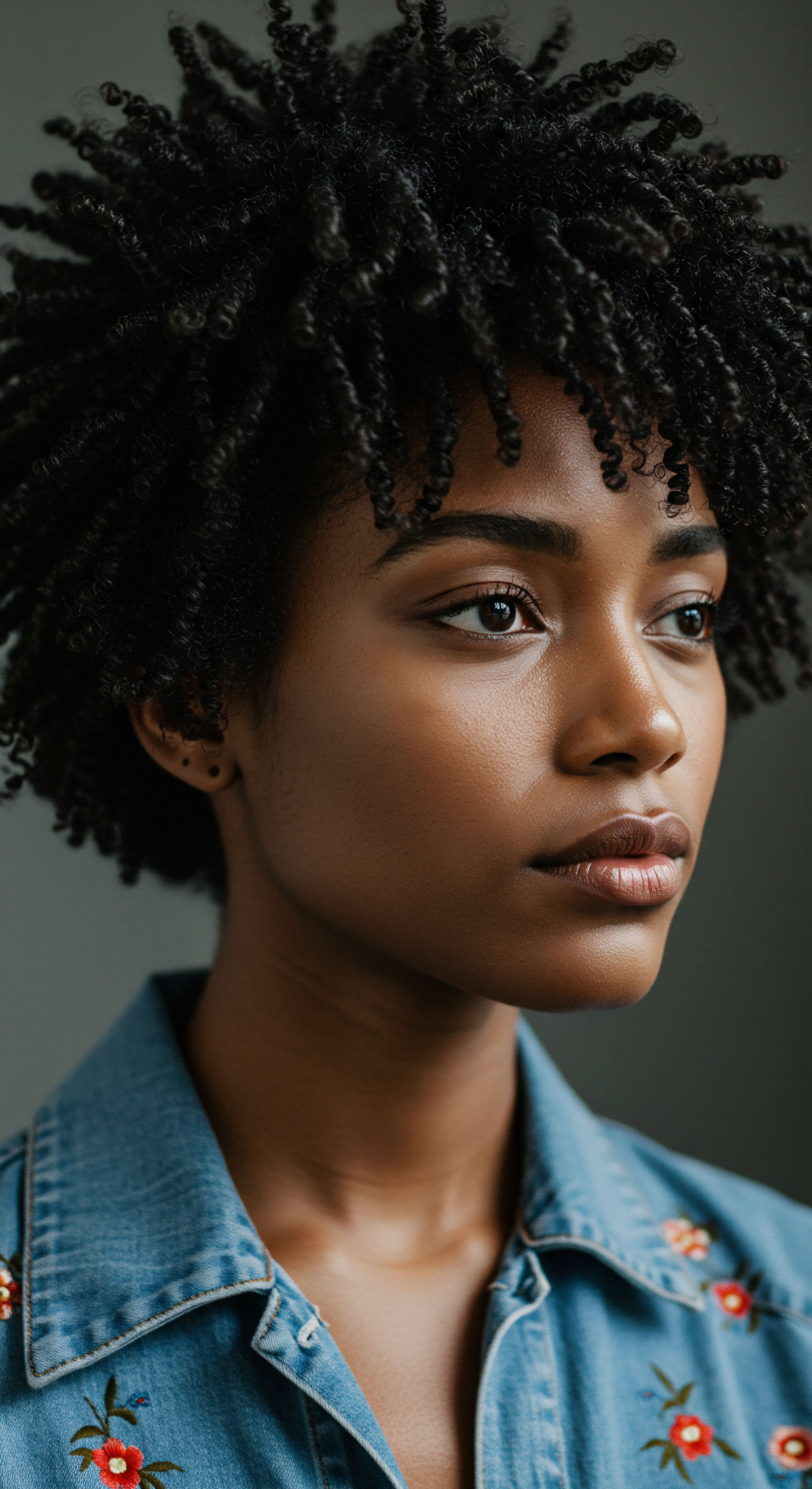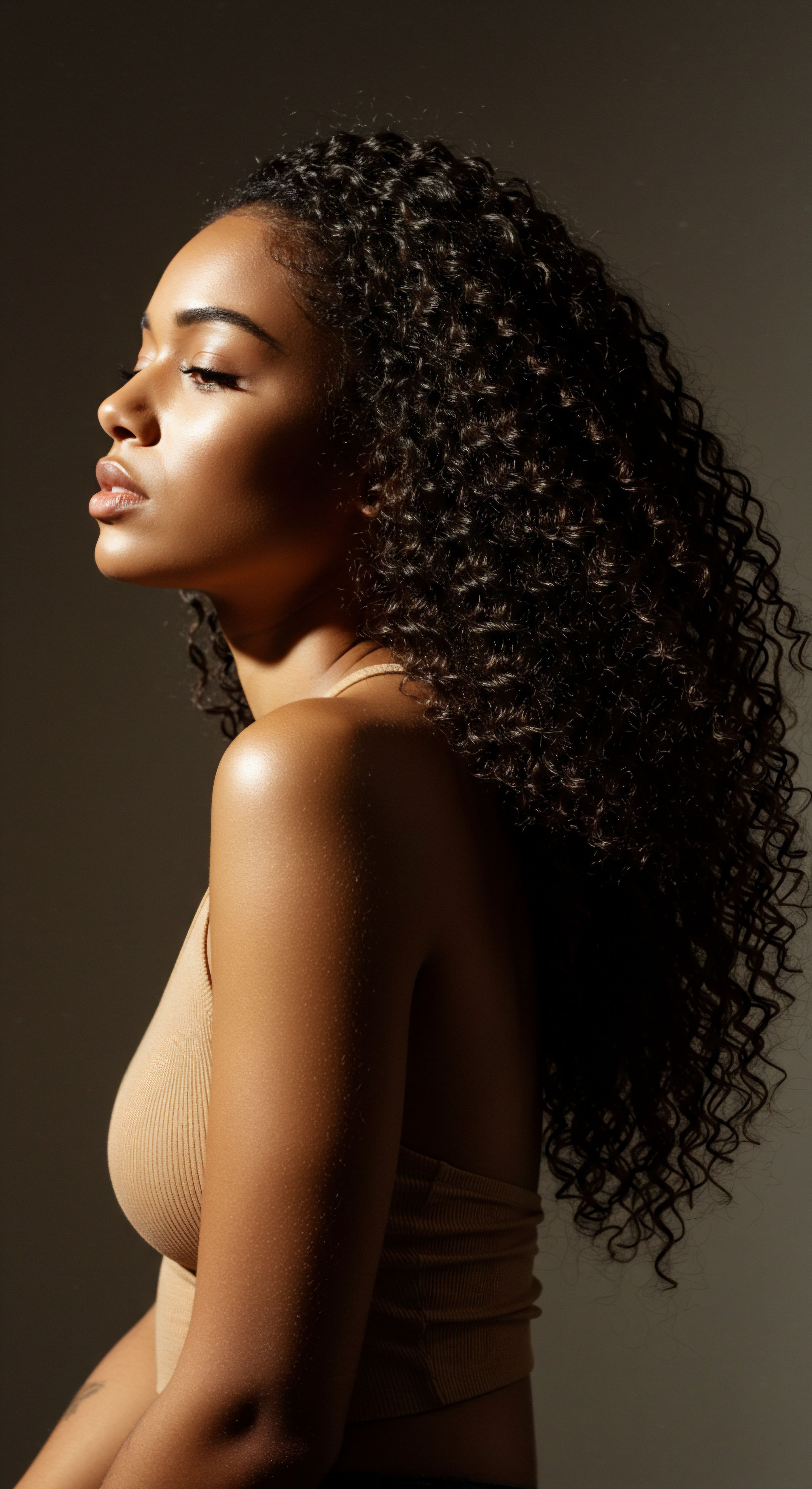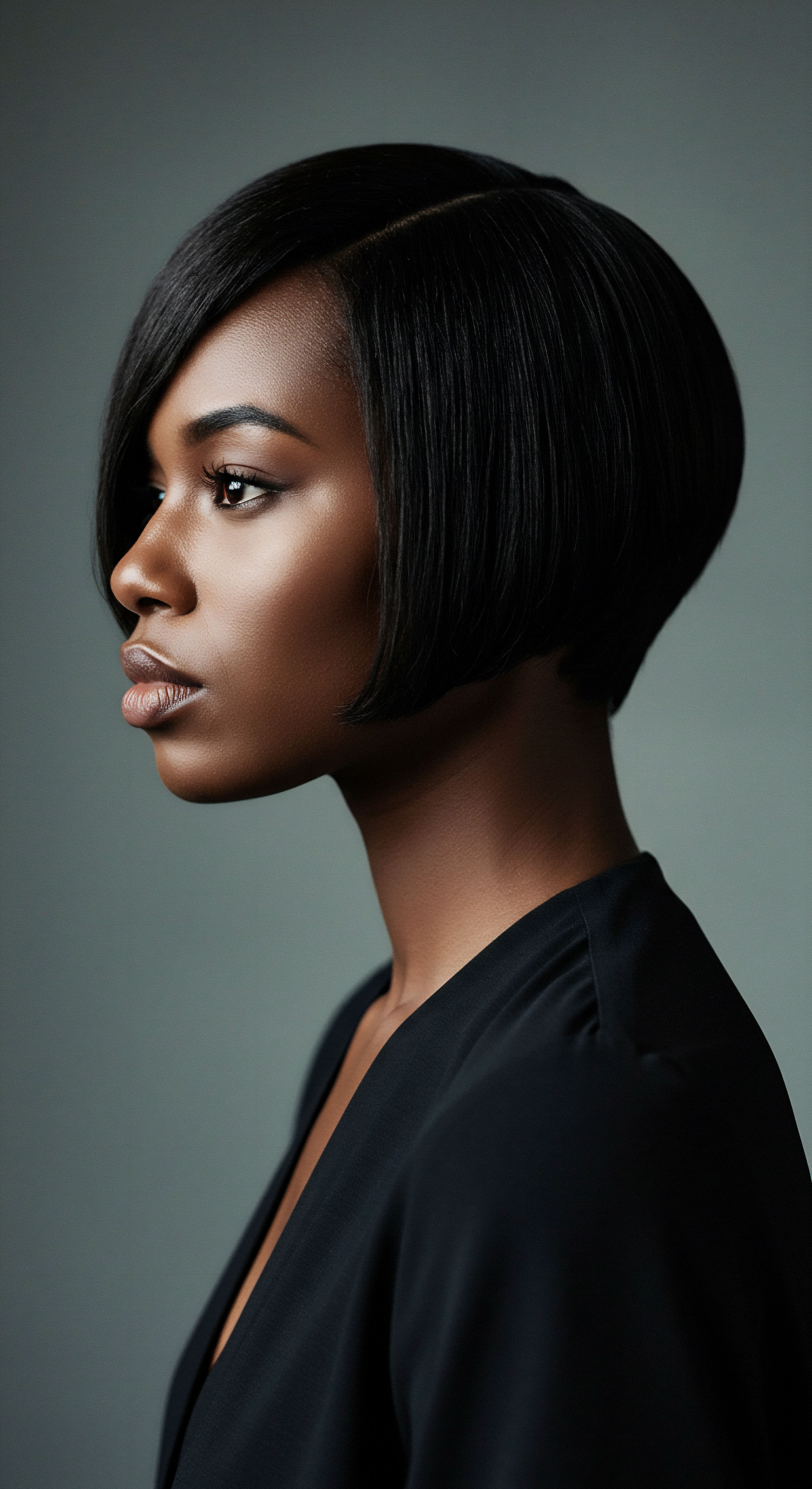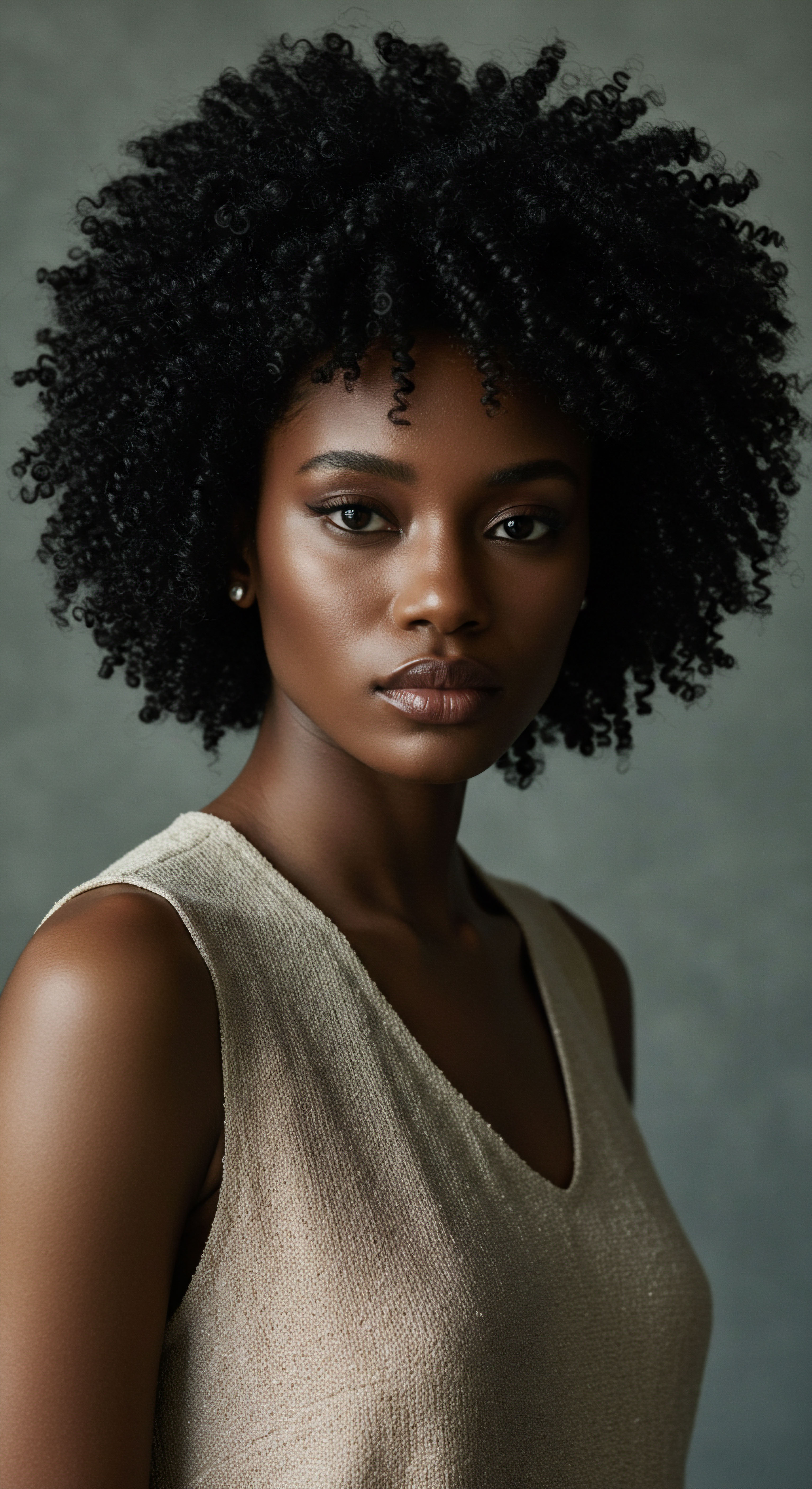
Roots
As the sun dips below the horizon, painting the sky in soft, fading hues, a quiet transformation begins. For countless generations, across diverse lands and eras, the approach of night has brought with it a gentle ritual ❉ the safeguarding of hair. This practice, often overlooked in our modern rush, carries whispers of ancient wisdom, a testament to the enduring understanding of hair’s delicate nature.
It speaks not just of vanity, but of protection, comfort, and the deep, abiding connection between our strands and our well-being. Roothea invites you to consider the foundational knowledge that shaped these nighttime traditions, recognizing how simple acts became profound gestures of care.

The Delicate Structure of Hair
Our hair, a seemingly simple outgrowth, possesses a complex architecture. Each strand, a marvel of biological engineering, comprises layers that work in concert to maintain its integrity. The outermost layer, the Cuticle, resembles overlapping scales, much like shingles on a roof. These scales lie flat when hair is healthy, reflecting light and providing a smooth surface.
Beneath this protective shield lies the Cortex, which gives hair its strength, elasticity, and color. The innermost core, the medulla, is not always present, particularly in finer hair types.
This layered construction makes hair susceptible to damage, particularly from friction. When hair rubs against rough surfaces, the cuticle scales can lift, chip, or even break. This leads to increased porosity, moisture loss, tangling, and breakage. Understanding this microscopic reality is a cornerstone of why traditional nighttime protection became so prevalent.

Why Nighttime Protection?
The hours of sleep, while restorative for the body, can pose challenges for hair. Tossing and turning, even subtly, creates constant friction against bedding. This mechanical stress, compounded over time, can compromise the hair’s external layer, leading to visible signs of distress upon waking.
Dryness, frizz, and tangles become unwelcome morning companions. Ancestral communities, long before scientific microscopes, observed these effects, recognizing the necessity of a nightly defense.
Traditional nighttime hair care acknowledges hair’s vulnerability to friction and moisture loss during sleep.
Moreover, hair naturally loses some moisture to the surrounding environment throughout the night. For hair types prone to dryness, particularly textured hair with its unique curl patterns and natural porosity, this moisture depletion is a significant concern. Protecting hair at night helped to mitigate this loss, preserving precious hydration and maintaining the hair’s natural oils.

Early Forms of Hair Protection
The earliest records of hair protection methods speak to ingenious adaptations of available materials. From simple wraps of cloth to more elaborate coverings, the goal remained consistent ❉ to create a barrier between hair and potentially damaging surfaces. These practices were not confined to one region but appeared in various forms across the globe, tailored to local resources and cultural aesthetics.
- Plant Fibers ❉ Early communities utilized readily available plant fibers to fashion wraps or coverings. These natural materials, while perhaps not as smooth as later innovations, still offered a degree of physical separation and containment for the hair.
- Animal Skins ❉ In some colder climates, softened animal skins or furs may have served a dual purpose, providing warmth and a protective layer for hair during sleep.
- Hair Styling ❉ Protective styles themselves, such as braids or coils, served as a foundational method of keeping hair contained and minimizing exposure to external elements, including during sleep. These styles reduced tangling and preserved length.

Ritual
Moving from the foundational understanding of hair’s needs, we step into the realm of practice, exploring the tangible methods and routines that protected hair through the night. These were not mere habits; they were often deliberate, mindful actions, passed down through families and communities, shaping the very way people interacted with their strands before rest. The quiet dedication to these nightly rituals speaks volumes about the value placed on hair health and appearance, a value that transcends time and continues to guide us today.

What Ancient Civilizations Used for Nighttime Hair Care?
Across ancient civilizations, particularly those with a deep appreciation for personal adornment and hygiene, specific practices emerged to safeguard hair during sleep. The materials and techniques varied, yet the underlying intention remained universal ❉ to preserve styles, prevent damage, and maintain overall hair condition.
In Ancient Egypt, for instance, wigs were commonplace, worn by both men and women of all social strata. These elaborate constructions, often made from human hair or horse hair, were removed at night. To protect their natural hair and scalp, and to maintain the integrity of their intricate hairstyles, individuals likely used soft linen wraps or coverings. Evidence also suggests the use of rich oils and balms, such as papyrus seed oil or argan oil, massaged into the scalp and hair as conditioning treatments, sometimes left overnight for deep nourishment.
Similarly, in various African Cultures, headwraps held immense significance beyond mere adornment. They served as symbols of status, identity, and cultural heritage, but also as practical tools for hair protection. Many traditional headwraps, often crafted from vibrant, intricately patterned fabrics, were used during sleep to shield hair from dust, dirt, and friction, preserving styled hair and promoting moisture retention.

How Did Different Cultures Protect Hair at Night?
The ingenuity of diverse cultures in protecting hair at night manifests in a variety of fascinating customs. These practices were often deeply interwoven with daily life, social customs, and the available resources of a region.
In some Asian Cultures, particularly those with a long history of silk production, silk hair wraps were highly valued. In ancient China, silk wraps were used by women to protect their hair, maintain elaborate hairstyles, and signify social standing. Korean noblewomen during the Joseon Dynasty also used silk headpieces to secure and protect their hair from environmental damage, ensuring smoothness and shine. The smooth surface of silk significantly reduces friction, a property understood and utilized long before modern scientific validation.
From silk wraps in Asia to patterned headwraps in Africa, materials chosen for nighttime hair protection were often those that minimized friction and preserved moisture.
Traditional Jewish Women, for example, often cover their hair with a tichel or snood, a practice rooted in modesty and religious observance. While primarily worn in public, the underlying principle of covering and protecting hair extends to nighttime routines, where softer, simpler coverings would be used to maintain hair’s neatness and health.
A closer look at the methods reveals common threads:
- Coverings ❉ The most widespread method involved wrapping hair in various materials. These ranged from simple cotton or linen cloths in everyday settings to more luxurious silk in affluent societies. The objective was to create a smooth barrier, reducing direct contact between hair and rough bedding surfaces.
- Braiding and Coiling ❉ Before covering, hair was often styled into protective configurations such as braids, twists, or coils. These styles kept strands contained, prevented tangling, and minimized stress on individual hairs during sleep. This was particularly beneficial for textured hair, which is prone to knotting and breakage.
- Oiling and Moisturizing ❉ Many traditions incorporated the application of natural oils, butters, or herbal concoctions to the hair and scalp before bed. This helped to seal in moisture, condition the strands, and reduce dryness that could otherwise be exacerbated by nighttime exposure. Ingredients like shea butter, coconut oil, or olive oil were common choices.

What Materials Were Used and Why?
The selection of materials for nighttime hair protection was not arbitrary; it reflected an intuitive understanding of hair’s needs. The ideal material would reduce friction, absorb minimal moisture, and provide a gentle enclosure.
| Material Silk |
| Common Usage East Asia, South Asia, Middle East, Europe (elite) |
| Primary Benefit for Hair Low friction, moisture retention, cuticle smoothness |
| Material Satin (historical equivalent) |
| Common Usage Varied, as fabric technology developed |
| Primary Benefit for Hair Smooth surface, reduced friction, less moisture absorption |
| Material Linen |
| Common Usage Ancient Egypt, various European cultures |
| Primary Benefit for Hair Breathable, offers physical barrier, absorbent (less ideal for moisture retention) |
| Material Cotton (as a covering) |
| Common Usage Widespread, accessible |
| Primary Benefit for Hair Provides a barrier, but higher friction and moisture absorption than silk/satin |
| Material Materials were chosen based on their ability to minimize hair damage and preserve moisture during rest. |
While cotton was widely accessible and used for general head coverings, its fibrous nature can create friction and absorb moisture from hair. This led many cultures, particularly those with textured hair or those valuing highly styled hair, to seek smoother alternatives for direct hair contact during sleep. The eventual adoption of silk and satin, where available, speaks to a recognition of their superior properties for hair preservation.

Relay
How deeply do these seemingly simple nighttime practices truly safeguard our hair, extending beyond mere appearance to touch upon identity, well-being, and even the very science of our strands? This question invites us to journey into the profound interconnectedness of traditional wisdom, cultural continuity, and the precise mechanisms that render these ancient methods so effective. It is a story told not only through historical accounts but also through the subtle language of our biology, illuminated by contemporary scientific understanding.

The Science Behind Traditional Protection Methods
At its heart, the efficacy of traditional nighttime hair protection rests upon fundamental principles of hair science. The primary adversaries of hair health during sleep are Friction and Moisture Loss. When hair rubs against rough surfaces like cotton pillowcases, the outermost cuticle layer experiences mechanical stress. This can cause the scales to lift, leading to a rough surface, increased tangling, and eventual breakage.
Consider the average person, who shifts position approximately 40 times per night. Each movement creates a resistive force between the hair and the sleep surface. This constant rubbing, over the course of a night and compounded over years, significantly contributes to cumulative cuticle damage.
Furthermore, cotton, a common bedding material, is highly absorbent. While excellent for towels, this property means it can draw moisture from the hair, leading to dryness, particularly for hair types that are already prone to dehydration, such as textured hair. Traditional coverings, especially those made from smoother materials, address these challenges directly.
Scientific understanding validates the ancestral practice of using smooth coverings and contained styles to combat friction and retain moisture during sleep.

The Role of Smooth Surfaces
The preference for silk and satin in many traditional hair protection rituals was not simply about luxury; it was a practical choice grounded in their unique physical properties. Silk, for instance, has a significantly lower coefficient of friction compared to materials like cotton. This means hair glides more smoothly over silk, reducing the mechanical stress on the cuticle.
A study conducted by TRI Princeton demonstrated that luxury silk was the smoothest material tested for hair friction, showing notably less resistance than cotton. This scientific validation confirms what generations intuitively understood ❉ a smoother surface means less snagging, less pulling, and ultimately, less damage to the hair shaft.
This reduction in friction also plays a critical role in preserving hair’s natural oils and applied products. When hair experiences less friction, its cuticle remains flatter, allowing the hair shaft to retain its natural moisture and any conditioning treatments for longer. This is particularly vital for maintaining hydration and preventing dryness, a common concern for many hair textures.

Cultural Continuity and Modern Applications
The enduring presence of these traditional methods speaks to their effectiveness and their deep cultural roots. For many Black women globally, the use of bonnets, headwraps, and silk scarves at night is not merely a beauty regimen but a continuation of practices passed down through generations, a connection to heritage and a form of self-care. This practice gained renewed significance during periods of enslavement, when head coverings, though sometimes imposed, were reclaimed as symbols of resistance, identity, and dignity, often used to protect hair from harsh conditions and maintain cultural continuity.
This historical resilience is particularly relevant when considering the impact of hair care practices on scalp health. For instance, while head coverings are beneficial, tight wrapping can sometimes lead to traction alopecia, a form of hair loss caused by prolonged tension on hair follicles. A study on religious head coverings and alopecia highlighted that women with afro-textured hair may be more susceptible to this condition due to fewer elastic fibers attaching hair follicles to the dermis, underscoring the importance of loose, gentle wrapping techniques, even within traditional practices. This data point, though perhaps less commonly cited in general hair care discussions, underscores the scientific precision needed even when honoring traditional methods, reminding us that protective practices must always be gentle and mindful of hair’s inherent vulnerabilities.
The cultural significance of these coverings extends beyond protection:
- Identity Preservation ❉ Head coverings served as a visible marker of cultural identity, especially in contexts where such identity was suppressed.
- Social Signification ❉ In many societies, the style, material, or color of a headwrap could convey marital status, age, or social standing.
- Spiritual Connection ❉ For some, covering hair holds spiritual or religious meaning, linking the physical act of protection to a deeper reverence for the body and its adornments.
The lessons from these traditional methods resonate strongly today. Modern hair care still advocates for the use of silk or satin bonnets, scarves, and pillowcases for nighttime protection. These contemporary tools are direct descendants of ancient wisdom, adapted with new materials but serving the same core purpose ❉ to shield hair from friction, preserve moisture, and maintain the integrity of our beautiful strands while we rest.

Reflection
The quiet moments before sleep, when hands attend to hair, carry an echo of countless generations. These traditional methods, born of observation, necessity, and an intimate connection to the body, stand as enduring testaments to a wisdom that precedes modern science yet finds validation within it. The simple act of covering hair at night, whether with a carefully folded cloth or a smooth silk wrap, speaks to a profound respect for our physical selves and a deep understanding of preservation. As we continue to seek ways to nurture our hair, looking back at these ancestral practices offers not only effective solutions but also a reminder of the rich heritage that shapes our routines, a gentle whisper of continuity across time.

References
- Byrd, Ayana and Tharps, Lori L. Hair Story ❉ Untangling the Roots of Black Hair in America. St. Martin’s Press, 2014.
- Block, Elizabeth L. Beyond Vanity ❉ The History and Power of Hairdressing. MIT Press, 2024.
- Petty, Kate. Hair (Around the World). Frances Lincoln Childrens Books, 2006.
- Weitz, Rose. Rapunzel’s Daughters ❉ What Women’s Hair Tells Us about Women’s Lives. Farrar, Straus and Giroux, 2004.
- Schwartz, S. & Knowles, M. Frictional Effects in Human Hair. Journal of the Society of Cosmetic Chemists, 1963.
- Bhushan, B. et al. Friction Dynamics of Straight, Curly, and Wavy Hair. Journal of the Mechanical Behavior of Biomedical Materials, 2014.
- El-Messiry, M. et al. Static Charge Accumulation on Polyester-Based Textiles and Its Effect on Hair. Textile Research Journal, 2017.
- Malinauskyte, Ernesta, Kang, Xuzi, and Gabarra, Marcella. The Fabric Factor ❉ The Role of Your Pillowcase and Hair Accessories in Hair Care. TRI Princeton, 2023.
- Abdel-Fattah, Mohamed. Ancient Egyptian Beauty Secrets That Still Work Today. Self-published, 2023.
- Rucker Wright, D. E. et al. Hair Care Practices and Scalp Disorders in African-American Girls. Pediatric Dermatology, 2011.
- Khumalo, Ncoza C. et al. Traction Alopecia in African Women ❉ A Clinical and Histopathological Study. Journal of the American Academy of Dermatology, 2008.
- Porter, J. C. et al. The Physical Properties of African Hair. Journal of the American Academy of Dermatology, 2005.
- Alexis, A. F. et al. Hair Loss in Women of Color. Journal of the American Academy of Dermatology, 2007.
- Loussouarn, G. et al. African Hair ❉ A Study of the Physical Properties of Hair from Different Ethnic Groups. International Journal of Dermatology, 2207.
- Aguh, C. & Okoye, G. Fundamentals of Ethnic Hair ❉ The Dermatologist’s Guide to Treating Hair Loss and Scalp Disorders in Patients of Color. Springer, 2017.